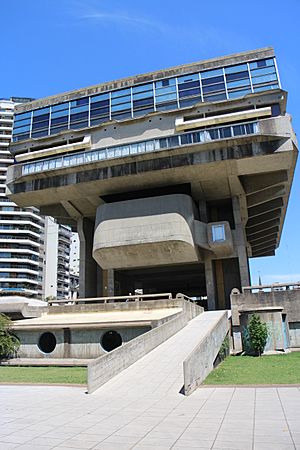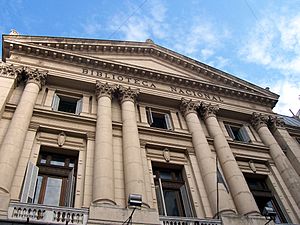National Library of Argentina facts for kids
Quick facts for kids National Library of Argentina |
|
|---|---|
 |
|
| The current building, photographed in 2013 | |
| Country | Argentina |
| Type | National Library |
| Established | 1810 |
| Location | Agüero 2502 Recoleta, Buenos Aires |
| Other information | |
| Budget | A$ 651,345,809 (2018) |
| Director | Juan Sasturain |
| Staff | 38 (2018) |
| Phone number | (0)11 4806 1929 |
The Mariano Moreno National Library (Spanish: Biblioteca Nacional Mariano Moreno) is the biggest library in Argentina. It is located in the barrio (neighborhood) of Recoleta in Buenos Aires. This important library is named after Mariano Moreno. He was a key thinker during the May Revolution, which led to Argentina's independence. He was also the library's very first director.
The National Library is part of Argentina's Ministry of Culture. It helps preserve the country's history and knowledge.
Contents
History of the Library
Starting as a Public Library
The library first opened in September 1810. It was called the Public Library of Buenos Aires. This happened by order of the first government after the May Revolution, known as the First Government Junta.
In 1884, it became the country's only national library. Its name officially changed to the National Library of Argentina. The first library building was an old mansion from the 1700s. It used to belong to the Jesuit religious order. This building was in a historic area called the Manzana de Las Luces.
Mariano Moreno, the first director, wanted to create the library to help people learn. He believed that public education was important for building an independent country. The first books came from different places. Some were from Bishop Orellana's personal collection. Others were donated by important groups like the Cabildo and the Real Colegio San Carlos. Manuel Belgrano, another important figure in Argentine history, also donated books.
The library's first main directors were Dr. Saturnino Segurola and Fray Cayetano Rodriguez. Later, Manuel Moreno, Mariano Moreno's brother, also became a director. Many famous Argentine thinkers and writers have led the library over the years. These include José Mármol and Jorge Luis Borges, who we will learn about later.
Becoming a National Library
When Buenos Aires became the capital city of Argentina, the Public Library became the National Library. Antonio Wilde was appointed as its director. He didn't stay long because he was old and passed away.
Paul Groussac took over as director. He created a detailed system to organize the books. He also started cataloging old handwritten documents. Groussac published two important magazines: La Biblioteca (The Library) and Los Anales de la Biblioteca (The Annals of the Library). These magazines became very famous.
Another big event was the opening of a new building in 1901. This building was on Mexico Street in the Montserrat neighborhood. It was originally built for the National Lottery. So, visitors were often surprised to see stairs decorated with lottery symbols!
During Groussac's 40 years as director, the library received many valuable donations. These included large collections of books and important historical papers. Like some other directors, Groussac eventually became blind. He continued to lead the library for some years before he died in 1929.
In 1931, the well-known writer Gustavo Martínez Zuviría became the library's director. He focused on making the library's services more modern. He also worked to grow the library's collection of books and documents. This helped to protect Argentina's heritage.
The next director was Jorge Luis Borges, a very famous Argentine writer. He managed the library from 1955 to 1973. Sadly, soon after he became director, he was told he would lose his eyesight. This meant he would no longer be able to read or write easily.
The New Building
Edmundo José Clemente, Borges's close friend and assistant director, played a big part in planning the new library building. This new building was constructed on the site of the Unzué Palace. This palace was where President Juan Perón and his wife Evita used to live.
After the Unzué Palace was torn down in 1958, the land was chosen for the new library. The design for the new building was created in 1961. It has a style called brutalist, which uses lots of raw concrete. However, construction didn't start until 1971. The new library finally opened its doors on April 10, 1992.
Changes in government and other delays caused the project to take a long time. The original architects were Clorindo Testa, Francisco Bullrich, and Alicia Cazzaniga. With the new building, there was a need for trained staff. This led to the creation of the National School of Librarians at the old library building.
See also
 In Spanish: Biblioteca Nacional (Argentina) para niños
In Spanish: Biblioteca Nacional (Argentina) para niños
- Asociación de Estados Iberoamericanos para el Desarrollo de las Bibliotecas Nacionales de Iberoamérica



